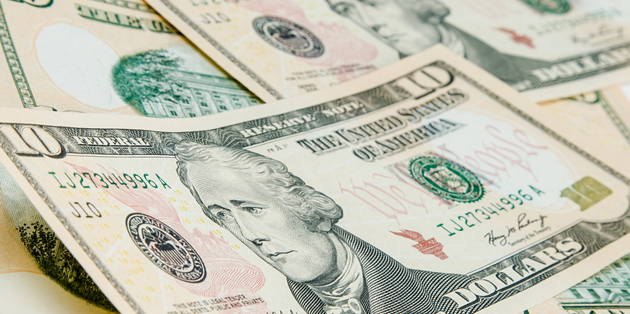- Euro Sturdy on Solid Data – German CPI meets preliminary results
- ECB President Draghi Urges Assistance – Warns of further Eurozone damage
- US Dollar Recovers in Risk-Off Trading – ‘Safe-haven’ currency recovers from lows
- Update: University of Michigan Confidence Cools – But drops less than forecast
- Forecast: US Fed Decision Next Week – Eurozone economic calendar relatively quiet
EUR/USD Trends Flatly as the Week Draws to an End
The Euro to US Dollar exchange rate fluctuated narrowly in the region of 1.1300 as Friday’s European session drew to an end.
US data released on Friday afternoon did little to inspire movement in EUR/USD, as the preliminary University of Michigan confidence report came in slightly better than expected. The figure slipped from 94.7 to 94.3, despite analysts expecting a score of 94.0.
As reported earlier, the event to look out for in the coming week will be the Federal Open Market Committee’s (FOMC) latest US interest rate decision. Analysts currently do not expect the Fed to hike rates in June.
(Published 10:42 10/06/16)
The Euro to US Dollar (EUR/USD) exchange rate trended flatly on Friday after being pushed down by a recovering US Dollar on Thursday. While the ECB President issued new warnings of economic difficulty in the Eurozone, the Euro remained sturdy on solid data.
EUR/USD has remained largely flat throughout the week as the Euro held its ground following last week’s dismal US labour report. After hitting a weekly high of 1.1413 on Thursday, the pair lost around -100 pips and now trends in the region of 1.1300. EUR/USD is slightly down on the week’s opening levels of 1.1366.
Euro (EUR) Slips Slightly on Draghi’s Latest Warnings
The Euro remained relatively sturdy on Friday as risk sentiment dropped, increasing the appeal of relatively safe currencies and boosting both the US Dollar and the Euro against other majors.
Eurozone data has also been solid in the last few days. Thursday’s session saw the release of the latest forecast-beating German trade data.
The trade surplus slipped from 26.2b to 25.6 despite being predicted to fall to 21.3b. Exports remained stagnant on March’s score of 1.9%, rather than contracting by -0.9% as some analysts feared.
Friday’s session followed up with May’s final German Consumer Price Index (CPI) figures. All figures met preliminary results as forecast, meaning the monthly score came in at 0.3% and the year-on-year score hit 0.1%.
However, not all news for the Eurozone was positive. Thursday’s session had markets reacting to news that German 10-year bond yields were slipping increasingly closer towards zero – and record lows. As a result, some economists predict that markets may attempt to take German bond yields into negative territory.
The Euro was also slightly pressured by European Central Bank (ECB) President Mario Draghi’s latest warnings as he urged politicians and financial ministers in Eurozone nations to assist the economy with their own reforms;
‘So it is in fact in everybody’s interest to act without undue delay. For the ECB, this means that we do not let inflation undershoot our objective for longer than is avoidable given the nature of the shocks we face. For others, it means devoting every effort to ensuring that output is returned to potential before subpar growth causes lasting damage. And given the harm that has already occurred to potential growth during the crisis, it also means acting decisively to raise potential.’
US Dollar (USD) Recovers as Risk-Sentiment Drops
The US Dollar spent much of this week reeling from last week’s NFP shocker, but investor appetite towards the Dollar has finally begun to normalise since last Friday’s scathing US labour report.
An increasingly risky global market is part of the reason the US Dollar has recovered. With investors beginning to profit-take on risk-currency highs and the Pound Sterling becoming increasingly risky, demand for ‘safe-haven’ currencies like the US Dollar has increased.
The ‘Greenback’ was also assisted during Thursday’s session by the latest jobless claims data, which came in better than expected. The number of initial jobless claims came in at 264k, beating expectations of 270k, while the amount of continuing claims improved from 2172k to 2095k.
However, these figures may be due in part to news that many jobless claimants had given up in searching for work in May, as indicated by last week’s poor US labour data.
With labour data still weighing on the US Dollar, its recovery against the Euro was slightly muted. The Q1 household change in net worth report was also mixed, falling from $2180b to a much lower $837b.
Euro to US Dollar (EUR/USD) Exchange Rate Forecast: Fed Decision Next Week
The moment of truth is near, but for many investors the decision became obvious following last week’s poor US labour data.
While some investors still speculate that the Federal Reserve could hike the key interest rate in its Federal Open Market Committee (FOMC) meeting on the 15th of June, the majority now expect that a hike is off the table until at least July.
The Euro to US Dollar exchange rate still has the potential to shift before this week ends however. The preliminary May University of Michigan Confidence report is due later on Friday.
Current forecasts point to the score slipping from 94.7 to 94.5, but a bigger fall than this could weigh on the appeal of the US Dollar.
The Euro, on the other hand, is likely to remain sturdy as markets draw to a close this week, and Eurozone data next week is set to be relatively quiet. Eurozone industrial production is due on Tuesday, with the final May Consumer Price Index (CPI) figures due later in the week.
The Euro to US Dollar (EUR/USD) exchange rate currently trends in the region of 1.1300, while the US Dollar to Euro (USD/EUR) exchange rate trades at around 0.8850.



